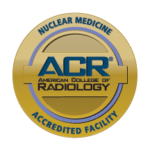Nuclear Medicine Imaging: How It Works
What is Nuclear Medicine in Radiology?
A highly specialized area within radiology, nuclear medicine uses very small amounts of radioactive materials (also referred to as radiopharmaceuticals) and a special camera to evaluate organ function and structure. It is often used in the early diagnosis of certain diseases, such as thyroid, liver, and kidney cancer. It is also used for certain types of cardiac imaging, such as myocardial perfusion scans and radionuclide angiography scans.
Most nuclear medicine scans are two-dimensional in nature. PET is also a form of nuclear medicine, but it has three-dimensional capabilities. A nuclear medicine gallium scan is used to diagnose tumors, certain inflammatory diseases, and abscesses. A nuclear medicine bone scan can detect degenerative conditions, bone tumors, and other types of disease.
Nuclear Medicine at A.T. Radiology
Our Siemens e.Cam Dual Head gamma camera features detectors that can be configured at variable angles. This enables us greater clinical flexibility to optimize sensitivity and output for cardiology, oncology and neurology exams. It can accommodate patients up to 400 pounds and features interactive multimedia options to improve the patient experience.
Preparing For A Nuclear Medicine Exam
For most nuclear medicine examinations, your doctor will inform you if any special preparation is needed. Please inform the technologist or one of our patient representatives if you are pregnant or think you might be pregnant.
Preparing for an I 123 Thyroid Scan/Uptake
- For 12 weeks before the exam, no intravenous radiographic contrast.
- For 6 weeks before the exam, no Synthroid.
- For 4 weeks before the exam, no iodine-containing vitamins or dietary supplements.
- For 2 weeks before the exam, no thyroid medications (desiccated thyroid, PTU).
Preparing for a Hepatobiliary Scan
- No food or drink on the day of the exam.
Preparing for Bone and Other Scans


